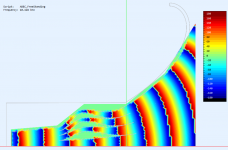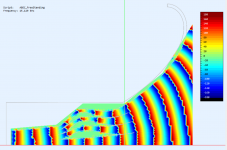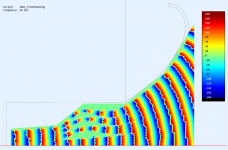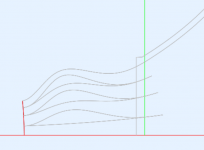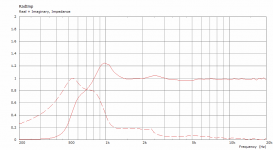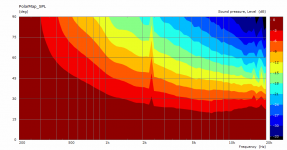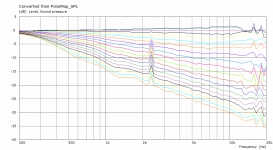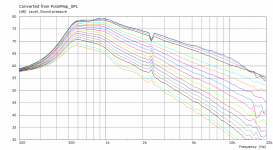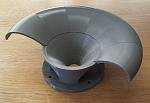Very interesting!
It's super nice to see the wavefront converting from flat to spherical ��
It's super nice to see the wavefront converting from flat to spherical ��
The whole point is that the conversion from flat to spherical is done by means of the narrow channels where HOMs don't apply (are pushed out of the audioband). The wavefront doesn't even know it's being converted 🙂
It's still not perfect however, I'm still chasing some minor issues...
It's still not perfect however, I'm still chasing some minor issues...
Last edited:
The same data not normalized, constant acceleration source (0-90 / 5 deg).
If it only worked up to 12 kHz as shown...
If it only worked up to 12 kHz as shown...
Attachments
Last edited:
Looks good!
I received the .2mm nozzle and getting my printer to print with it atm.
Meanwhile I was thinking that a similar technique could be used to make a multicell horn, but instead of revolving - lofting could be used to do one segment at a time.
It would take significantly longer to simulate in 3d tho..
I think multicell horns are so awesome, and it's a pitty they have the issues they do 😀
I received the .2mm nozzle and getting my printer to print with it atm.
Meanwhile I was thinking that a similar technique could be used to make a multicell horn, but instead of revolving - lofting could be used to do one segment at a time.
It would take significantly longer to simulate in 3d tho..
I think multicell horns are so awesome, and it's a pitty they have the issues they do 😀
That will take a few days 🙂I received the .2mm nozzle and getting my printer to print with it atm.
- That's the beauty of SLA printing, it takes the same amount of time no matter how big or complex shape is printed, only the height is what counts. The printer I have is too small for the whole 2" plug, I would have to print it in several parts (not sure I want to do that, maybe I will try).
Last edited:
Stupid question but I have to ask:
What is the advantage of having a Spherical wavefront over a flat one?
What is the advantage of having a Spherical wavefront over a flat one?
Once we have a spherical wave we can have constant directivity for an arbitrarily big source. Flat wavefront will beam on high frequencies, depending on its diameter. With the approach presented here we can produce a spherical wavefront as a result of an exponential expansion (i.e. with high efficiency), which would be a remarkable feat.
Makes me wonder what is a typical total area expansion inside a common phase plug. Is that even a consideration? Shouldn't this be smoothly continued in the horn?
I've been saying that for more than a decade. The driver manufacturers can do all this stuff, they just aren't interested.
I looked at this problem a bit and concluded that the shorter the phase plug "throat" the less of a problem that it was. That's why I settled on the B&C DE500, because it has the shortest "throat" of any driver that I had looked at.
I looked at this problem a bit and concluded that the shorter the phase plug "throat" the less of a problem that it was. That's why I settled on the B&C DE500, because it has the shortest "throat" of any driver that I had looked at.
And what about the phase plug channels? It seems to me that they are part of it as well, at least in the form of their area sum.
To me the JBL 2450SL and 2451, fitted with Be diaphragm, looks like good candidates. I think I read somewhere that their "coherent wave" phase plugs have a well defined expansion rate somewhere around or slightly below 200Hz.
//Anders
//Anders
Once we have a spherical wave we can have constant directivity for an arbitrarily big source. With the approach presented here we can produce a spherical wavefront as a result of an exponential expansion (i.e. with high efficiency), which would be a remarkable feat.
A portion of a spherical surface, large compared to the wavelength and vibrating radially, emits uniform sound radiation over a solid angle subtended by the surface at the centre of curvature.
Assuming that it proves possible to produce a spherical wavefront where the radial air motion has the same phase and amplitude over the cap surface at the exit from the phasing channels (despite some of the channels having bends), if the main horn profile flares at a rate greater than that defined by the spherical cone, then the wavefronts will not remain truly spherical across the entire horn cross-section as they progress along the axis towards the mouth. This will be particularly so if a Le Cléac'h type fold-back is employed at the mouth.
Interestingly, in his profile-generating algorithm Jean-Michel made provision for having either a curved or a plane wavefront at the horn throat.
The rest of the waveguide is a simple matter of numerical optimization. What I already realized is that a "too conical" horn will get too wide at high frequencies. I don't really care what the "Le Cléac'h type fold-back" is, as it always seemed too much of a hand waving to me.
I don't think there is a past in a horn/wg that don't matter for the rest of the journey to the mouth. The whole thing is an organisms from start to end and "everything matters" - seems like David has some insight here that might be better digested if taken along with a small piece of humble pie dessert!? ;-D
//
//
Go ahead!
I already showed several BEM simulations of the whole thing. The only obvious requirement is that the wavefront is sufficiently uniform on the input. Maybe that's too much to ask in practice, we don't know yet.
I already showed several BEM simulations of the whole thing. The only obvious requirement is that the wavefront is sufficiently uniform on the input. Maybe that's too much to ask in practice, we don't know yet.
Last edited:
I don't really care what the "Le Cléac'h type fold-back" is, as it always seemed too much of a hand waving to me.
So why do you have one on your horn / waveguide?
Jean-Michel was the first person, to my knowledge, to take the flare tangent angle beyond 90 degrees.
Attachments
- Home
- Loudspeakers
- Multi-Way
- Acoustic Horn Design – The Easy Way (Ath4)
